Data shows that only 27% of SMBs are very confident in their marketing strategies. The vast majority of business owners either underinvest in marketing or adopt a haphazard approach without first formulating a marketing strategy to use as their North Star.
It’s no secret that AI-powered marketing tools and shifting consumer behaviors redefine how SMBs connect with their target audiences at lightning speed. This makes it even more difficult for businesses to handle marketing by themselves. Thus, marketing agencies that continuously stay on top of advertising trends become indispensable.
This article aims to keep you up to speed with the most impactful shifts in the marketing industry. Let’s dive in!
Acquire and serve 10x more clients with AI-powered software
1. The Rise of Artificial Intelligence in Advertising
AI-Powered Ad Optimization
According to PPC trends, using platforms that leverage machine learning to run search ads on Google or Bing is the best way to guarantee marketing automation ROI to your clients. Why?
Here are the top three reasons:
- Artificial Intelligence analyzes user behavior and search patterns to deliver ads to the right audience at the right time.
- Artificial Intelligence automatically adjusts bids based on real-time auction data, ensuring optimal ad placement at the best cost.
- Artificial Intelligence continuously refines keyword targeting based on real-time search trends and competitor data, enhancing AI-generated content for digital campaigns.
If you have SMB clients who don’t quite appreciate digital advertising, Vendasta has an inspiring story to share. One of Vendasta’s partners, Anderson Marketing Group, had a client, Precision Autobody, who was reluctant to diversify into new channels beyond local radio advertising.
Yet, by demonstrating the digital advertising campaigns’ indisputable ROI, the marketing agency was able to win over the SMB owner and facilitate their growth. 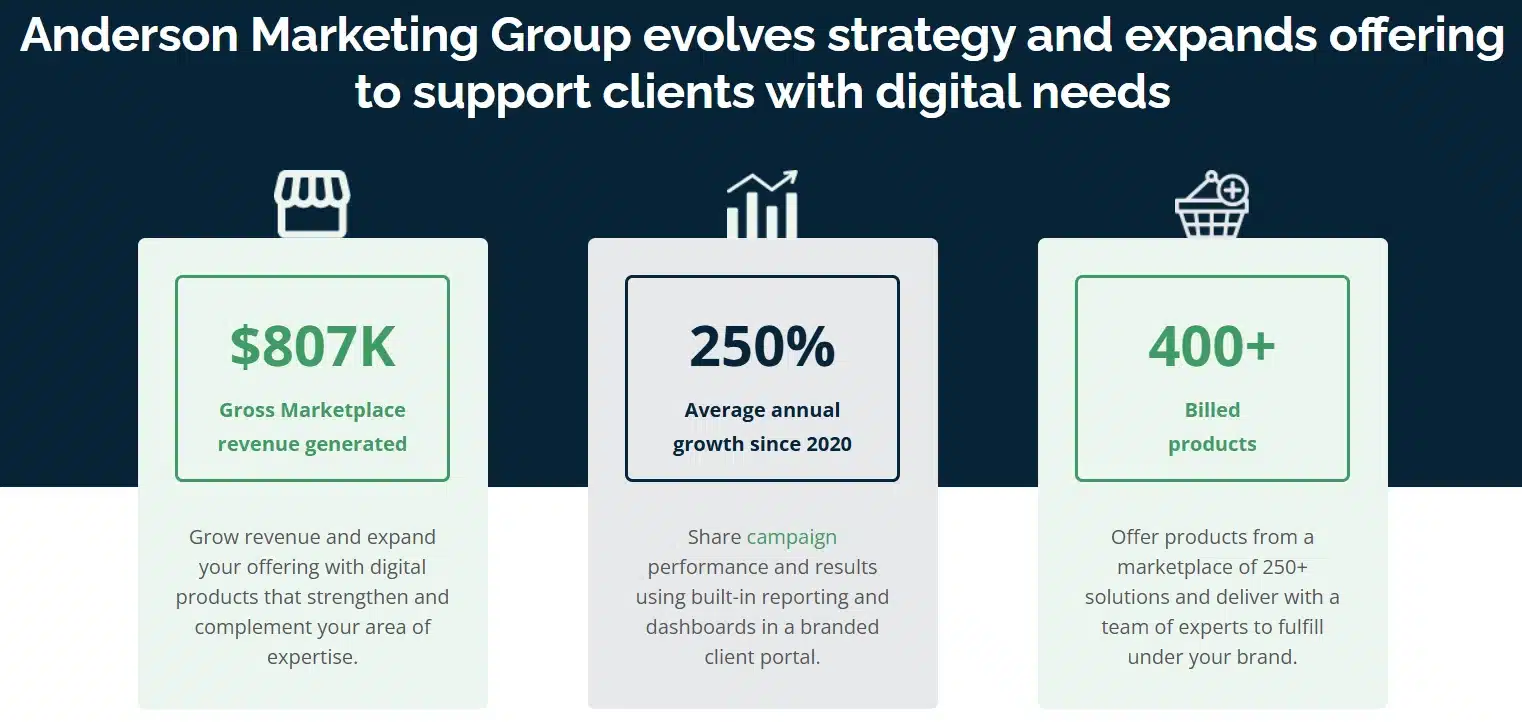
As AMG’s business development manager, Darren Anderson put it: “Precision Autobody bought the building next to them, and they’re actually busier, bigger, and better than ever.”
What’s the secret behind this success? Vendasta’s white-labeled PPC reporting software, Advertising Intelligence, empowers marketing agencies to decrease their operational costs and improve ad performance with AI digital marketing.
Generative AI in Content Creation
If you have SMB clients who are reluctant to trust AI-generated content, consider sharing the following insights with them.
1. AI-written social ads are more effective than those written by humans alone.
Why? AI analyzes extensive datasets to identify patterns in consumer behavior and preferences and tailor the ad copy accordingly. What’s more, AI surpasses humans in A/B testing ad copies to find what clicks with prospects and customers.
Proof? By integrating Phrasee’s AI-powered copywriting tool, Wowcher achieved a 31% reduction in cost per lead (CPL) in Facebook advertising as well as an increased Relevance Score.
Pro Tip: If you’re looking for a white-label social media marketing platform that’s well-integrated with other marketing tools, give Vendasta a try. Our AI-powered social media management software enables you to manage thousands of client accounts under one roof.  2. AI marketing tools do not replace human copywriters but rather help improve content quality and efficiency to ensure long-form content meets the high standards of SEO and generative engine optimization (GEO).
2. AI marketing tools do not replace human copywriters but rather help improve content quality and efficiency to ensure long-form content meets the high standards of SEO and generative engine optimization (GEO).
Here are the top reasons why:
- AI tools help marketers identify the best keywords based on search volume, competition, and user intent. They also help marketers effectively integrate these keywords into the content.
- AI generates click-worthy headlines and meta descriptions, boosting organic click-through rates (CTR).
- AI improves content authority and user experience by suggesting relevant links to keep readers engaged.
- AI tools, such as Frase, suggest content that answers the most common questions related to a particular topic.
- AI analyzes top-performing content on any given target query and comes up with actionable, research-driven strategies on how marketers can optimize their own content.
2. How Short-Form Videos Change Digital Marketing
Popularity of Bite-Sized Content
These days, consumers have shorter attention spans and prefer engaging and visually stimulating content. As part of evolving advertising trends, short-form videos have become a powerful way to connect with audiences. This video format works best to entertain and educate prospects to convert them into customers.
Mastering the best social media marketing tactics for small businesses can significantly improve brand awareness and engagement. Here’s an overview of the different types of video ads with tips on when it’s best to use each of them: 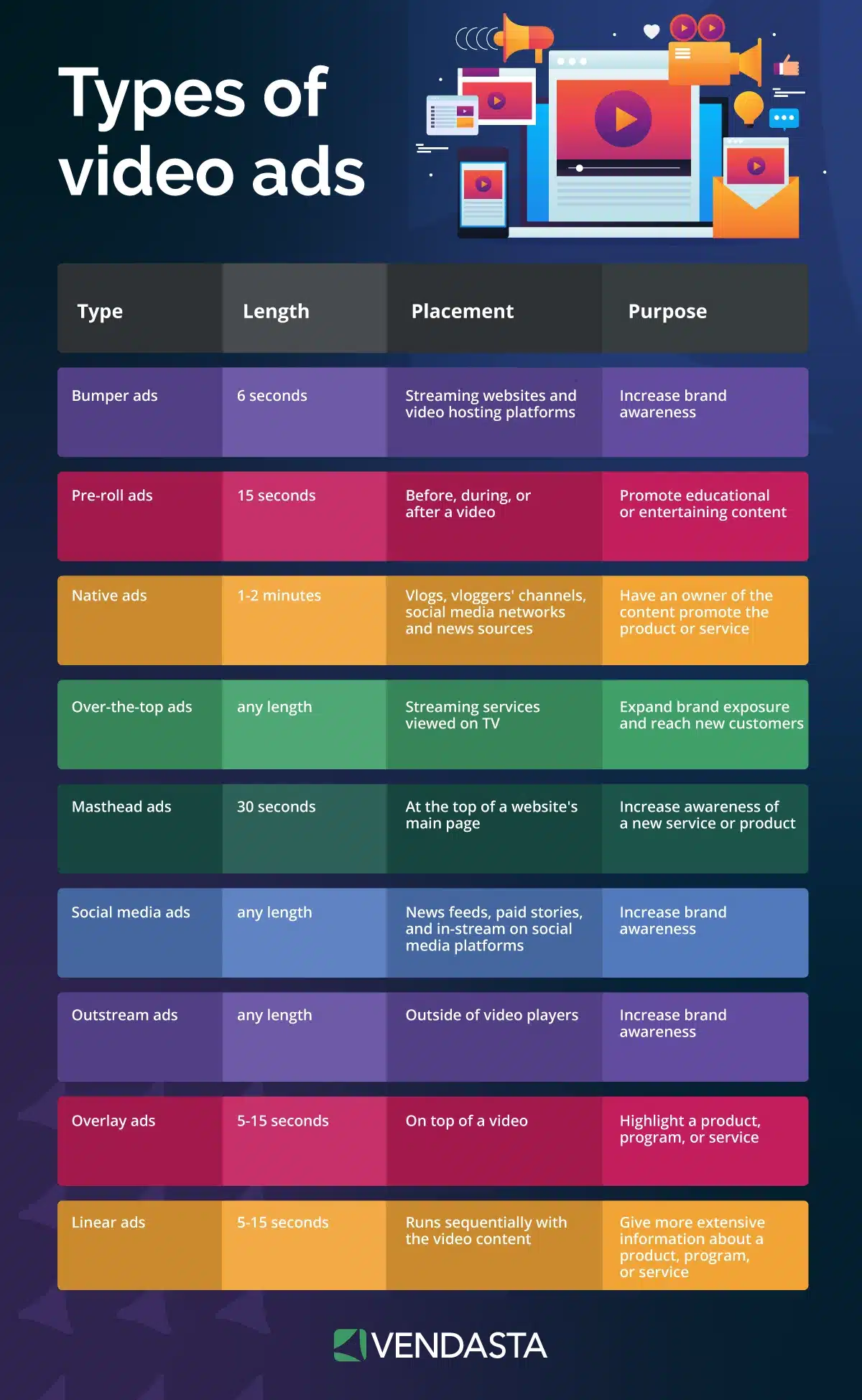
Pro Tip: If you are looking for tools to help you track video ad performance alongside paid search, social, and display advertising campaigns that you run for your clients, Vendasta MatchCraft’s Video Ads can help.
Integration of Interactive Elements
Gamification is a current hot advertising trend, and just as there are many types of video ads, there are plenty of ways to make ads more fun.
Ads with interactive features are one example. Here’s a non-exhaustive list of interactive elements to leverage:
- Shoppable links and product tags allow users to purchase directly from the ad.
- Clickable CTAs drive users to a website, app, or landing page.
- Swipe-up links direct users to a product page or website.
- Interactive carousels allow users to swipe through multiple images, offers, or features.
- Dynamic forms can be completed within the ad.
- Scratch-off ads enable users to swipe or “scratch” the screen to reveal discounts or surprises.
Another example of interactive ads is in-game mobile ads. They fall into these categories:
- Interstitial Ads: Appear at natural breaks in gameplay, such as between levels or when a user pauses the game.
- Rewarded Ads: Players can choose to watch this type of ad in exchange for in-game rewards, such as extra lives, currency, or power-ups.
- Playable Ads: Users can try a mini-version of another game or product before downloading.
- Offerwall Ads: Users complete tasks (e.g., watching multiple ads, filling out surveys, or installing apps) in exchange for in-game rewards.
Many assume that children and teenagers make up the majority of mobile game players, but this is a common misconception. If your clients are hesitant about leveraging in-game mobile ads to reach their target audience, the following statistics may prompt them to rethink their approach:
- According to Statista, 30 to 39-year-old players constitute a large portion of smartphone gamers in the U.S.
- Big companies, such as Unilever, Coca-Cola, and Ford, started diversifying their advertising efforts into in-game mobile ads.
- According to Business of Apps, 65-75% of mobile gamers accept ads, which is helpful to know because this means players don’t get irritated whenever they are targeted with product offerings during a playthrough.
All in all, in-game mobile ads are worth checking out.
3. Authenticity and Transparency in Brand Messaging
Consumer Demand for Genuine Connections
Polished and corporate-sounding ads no longer work. With so many influencers and vloggers appearing on social media, people have become used to trusting real-life stories rather than sales pitches. Also, with the growing awareness of social issues, such as social inequality and climate change, customers choose brands that share their values.
As these trends show, trust is the cornerstone of effective advertising. Many statistics support this statement. For example, according to the 2019 Edelman Trust Barometer Special Report, brand trust is a deciding factor for 6,000 people in eight countries when they consider making a purchase.
With this in mind, how can your agency help your SMB clients build trust with their target audiences? Here are three key strategies.
Authentic Storytelling
Here’s a list of techniques that can help you make your clients’ brands more humane and relatable:
- Use real customer stories instead of stock imagery and generalized messaging.
- Highlight behind-the-scenes moments, showing the human side of the brand.
- Be honest about challenges, mistakes, and how the company is improving.
User-Generated Content (UGC)
When real customers share their experiences, it creates social proof, making your clients’ brands more credible. According to Flocker, consumers trust UGC 2.4 times more than brand-created content.
As advertising trends continue to shift toward authenticity, UGC remains one of the most effective ways to build trust and drive engagement.
If you choose to make UGC part of your advertising strategy, here are some ideas on how to incentivize your clients’ customers to share their experiences:
- Create branded hashtags to encourage customers to share experiences using a specific hashtag.
- Run UGC campaigns and contests to offer rewards for the best user-created content.
Employees as Advocates
Another cost-effective way to enhance the authenticity of your clients’ brands is to recruit employees as brand advocates.
The MLSGroup’s survey strongly supports using employee-generated content in marketing. It found that content shared by employees generates eight times more engagement than content posted on brand channels, and leveraging employee advocacy can expand brand reach by 561%.
How can you secure employees’ support?
- First, educate employees on best practices for sharing content by developing a playbook on what to share, how to engage, and tone of voice.
- Consider using tools to streamline content sharing.
- Offer branded templates, captions, and visuals for employees to personalize.
- Implement leaderboards, contests, or point systems for top advocates.
- Feature employees in blogs, social media takeovers, and video testimonials.
4. Expansion of Social Commerce and Influencer Marketing
Seamless Shopping Experiences on Social Platforms
Modern consumers crave convenience, and social commerce delivers just that—frictionless, one-click purchasing from their favorite social media apps.
Here are some popular in-app purchasing venues:
- Instagram and Facebook Shops enable brands to create fully functional online stores within their social profiles.
- Pinterest Shopping Pins turn product images into shoppable posts, linking directly to checkout pages.
- TikTok Shop allows brands and influencers to tag products in videos for instant purchases.
- YouTube Shopping lets creators showcase and sell products directly from their content.
Collaborations with Influencers
Social commerce isn’t just about where people shop—it’s also about who influences their purchasing decisions.
If you want to leverage influencer partnerships to promote your clients, you may want to consider these best practices:
- Select the Right Influencers: Choose influencers who align with the brand’s audience and values.
- Use Shoppable Content: Ensure influencers tag products directly in posts and videos.
- Leverage Live Shopping Events: Host Instagram Lives, TikTok Shop streams, and YouTube Live Shopping to create urgency and real-time engagement.
5. Data Privacy and Ethical Digital Marketing
Navigating Privacy Regulations
Depending on whether you’ve got clients in the EU or the US, here are two lists of policies to keep in mind.
The European Union:
- GDPR: A data privacy law enacted by the EU in 2018 to protect individuals’ personal data and regulate how businesses collect, store, and process information.
- Digital Markets Act: This Act that came into force in 2023 aims to prevent monopolistic behavior by big tech companies like Google, Apple, Amazon, Meta, and Microsoft.
- Digital Services Act: Effective in 2024, this Act focuses on content moderation, online safety, and accountability of digital platforms.
The United States:
- California Privacy Rights Act (CPRA): Passed in November 2020 and effective as of January 1, 2023, this Act expands upon the California Consumer Privacy Act (CCPA) to strengthen consumer privacy protections.
- 2024 Utah Artificial Intelligence Policy Act (UAIP): Enacted on March 13, 2024, and effective from May 1, 2024, this Act establishes a regulatory framework for the development, deployment, and use of artificial intelligence (AI) technologies within Utah.
Ethical AI in Advertising
While AI in marketing streamlines repetitive tasks, enhances targeting precision and provides valuable insights from complex data, it can also perpetuate biases if not carefully managed. As the comparison between AI vs. human intelligence demonstrates, AI lacks agency and subjectivity, making it incapable of ethical judgment.
Here are a couple of examples. If an AI advertising algorithm detects higher engagement from a specific audience, it may over-prioritize that group, inadvertently excluding others and leading to unfair targeting practices.
Similarly, an AI Image Generation tool trained on datasets that predominantly feature male engineers, female nurses, or Western beauty standards may produce visuals that reinforce harmful stereotypes.
As advertising trends continue to evolve, ethical AI practices are becoming a crucial consideration for marketers. So, what steps can your agency take to minimize the risks associated with AI?
Whenever you choose an AI marketing tool for your agency’s tech stack, make sure that you have a clear understanding of the provider’s AI development policy.
Here’s a list of the key principles guiding ethical AI development:
- Prevention of unauthorized access to customer data.
- Giving customers an option to forbid the use of their data in the process of developing AI features.
- Implementing human oversight.
- Using diverse, representative, and inclusive training data.
- Ensuring that the end users of the AI tools, as well as anyone impacted by them, have an understanding of the development process.
- Commitment to refining the AI tools based on recommendations by AI ethics boards.
- Openness to investigating consumers’ reports of perceived biases or unfair treatment.
Another step to take toward ensuring ethical AI use at your agency is to consider making an AI use policy for your employees. Atlas Marketing has a great example.
In general, an AI policy should include the following elements:
- Instructions for employees to disclose AI-generated content and inform customers and consumers when they are interacting with AI-driven chatbots or recommendation systems.
- List of AI tools that your agency uses and for what purposes.
- Outline an escalation process for AI-related errors or concerns.
- Define what client data your employees can and can’t use whenever they use AI to generate texts or visuals.
Pro Tip: Do you want to assemble an AI workforce that was developed in strict alignment with core ethical principles? Vendasta’s AI combines marketing and operational data with proprietary models to empower your agency to provide marketing services tailored to each of your clients, no matter their industry. 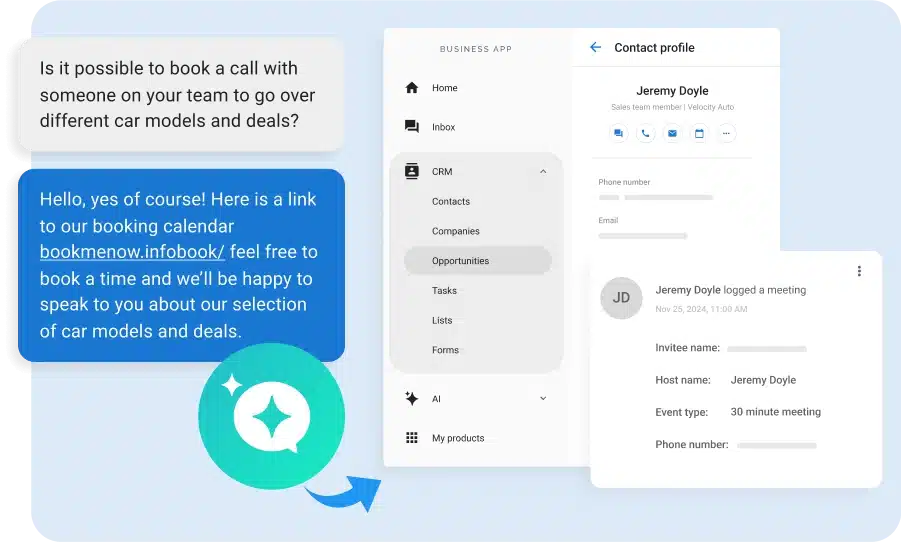
6. Voice and Conversational Advertising Trends
The Growth of Voice Search and Smart Assistants
Smart assistants, such as Alexa, Google Assistant, and Siri, are becoming an integral part of Western customers’ daily lives. Consumers use them for everything from checking the weather to shopping online.
In fact, according to stats, 2025 will see the use of voice assistants surge to 8.4 billion worldwide. With 1 billion voice searches performed every month, this is a marketing trend that your agency simply can’t ignore.
To master voice search optimization, here are a few points to keep in mind:
- Use Natural Language in Ads and Content: Align ad copy with how people speak, not how they type.
- Prioritize Featured Snippets: Voice assistants often pull answers from Google’s Position Zero (featured snippets).
- Optimize for Local Voice Search: Ensure Google My Business and location-based keywords are up-to-date (Vendasta’s reputation management can help with this task).
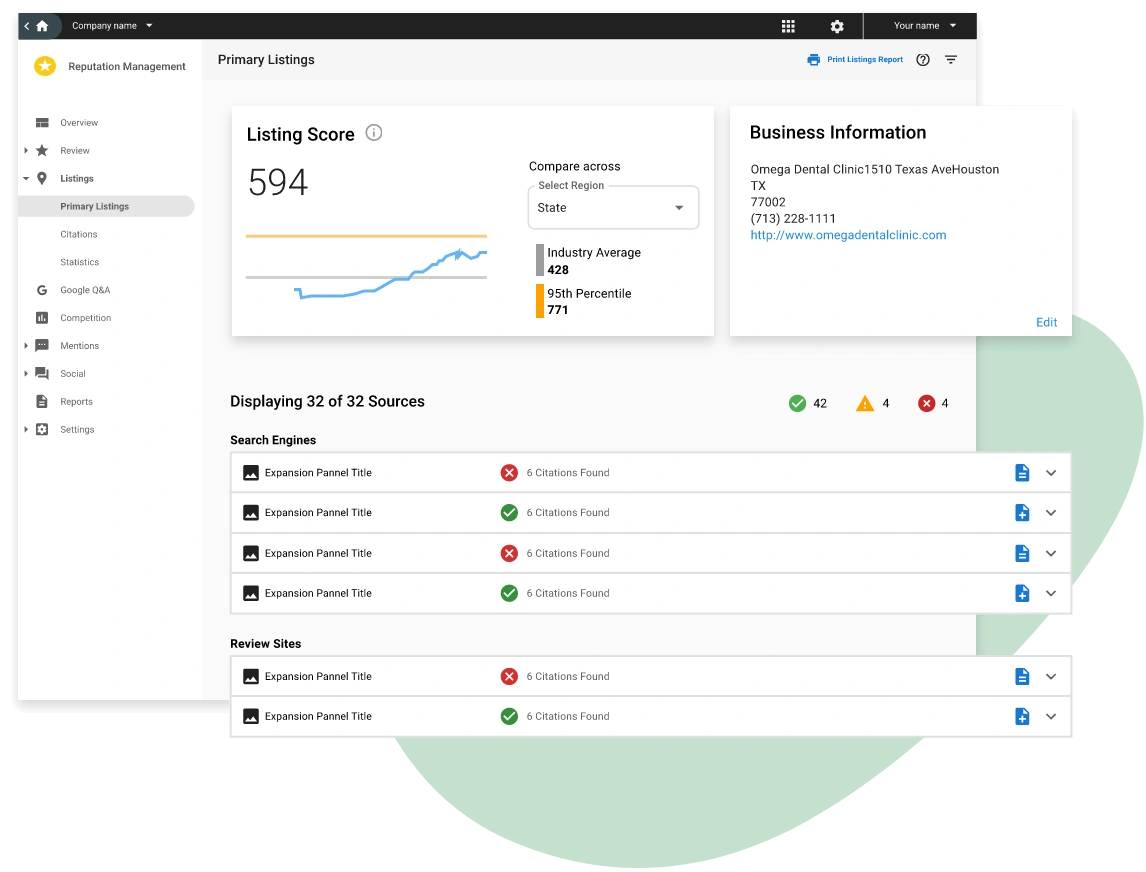
- Create FAQ-Based Content: Answer common customer questions in a conversational format.
- Leverage Audio Ads on Smart Devices: Run voice-activated ads on platforms like Amazon Alexa, Spotify, and Google Assistant.
Conversational Ads and Chatbot-Integrated Advertising
The term conversational marketing was first introduced by Drift, which defined it as:
“Conversational marketing is the fastest way to move buyers through your marketing and sales funnels through the power of real-time conversations. It builds relationships and creates authentic experiences with customers and buyers.”
Messaging platforms, such as LinkedIn inbox for LinkedIn Message Ads and the Messenger app for Facebook Messenger Ads, are the primary channels for conversational advertising.
Other key formats include conversational landing pages and chatbot banner ads:
- Conversational landing pages are interactive web pages that engage visitors in real-time through chatbots, live chat, or AI-driven prompts, delivering a more personalized and dynamic user experience.
- Chatbot banner ads are interactive display ads with built-in AI-powered chatbot functionality. Instead of directing users to a landing page, these ads initiate real-time conversations directly within the ad unit.
At its core, conversational marketing replicates the natural flow of dialogue between sales representatives and prospects, guiding potential customers along their journey. These interactions are typically powered by chatbots or virtual assistants equipped with conversational AI. 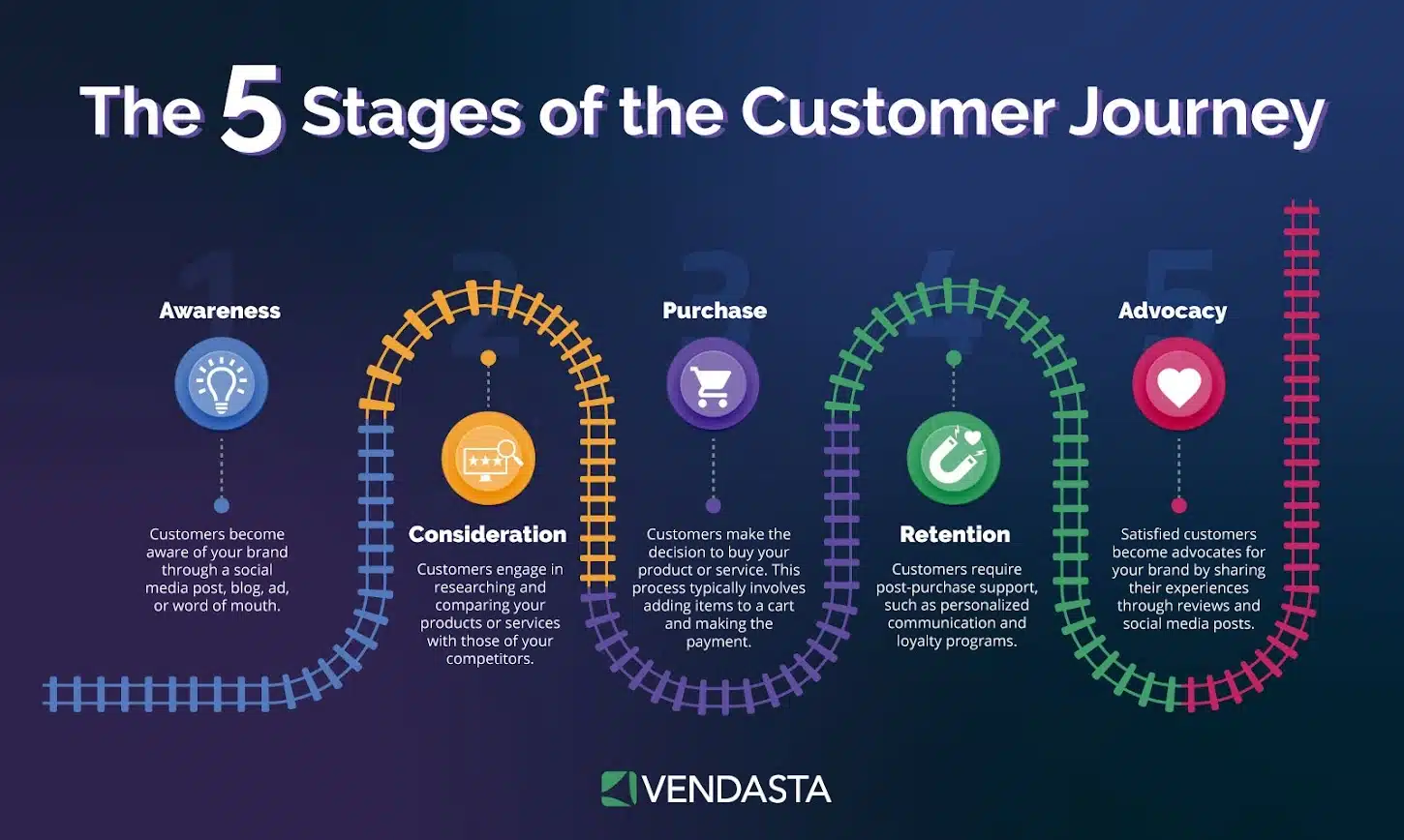
Pro Tip: If you want to start offering conversational advertising as part of your agency’s services, you may want to consider Vendasta’s white-labeled AI-assisted web chats.
By integrating intelligent chat functionality directly into websites, businesses can engage visitors in real-time, answer questions instantly, and guide prospects through the customer journey. 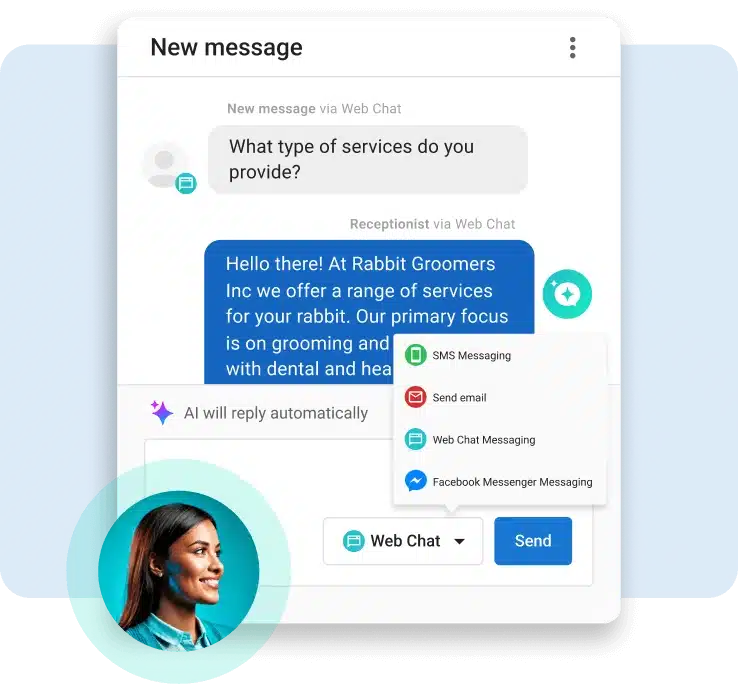
The Future of Advertising
As a bonus, here are a few more advertising trends to keep at the top of your mind.
Social Media Landscape
With X’s popularity in rapid decline and TikTok’s ban in the U.S. still up in the air, you may want to consider training your employees on a couple more social media platforms.
Here are some notable TikTok alternatives:
- RedNote (Xiaohongshu): Originally launched in China as a social commerce platform, RedNote has expanded its features to include short-form video content. Since TikTok’s ban, it has become one of the most downloaded apps in the U.S., attracting users with its personalized content algorithm.
- Clapper: Headquartered in Dallas, Texas, Clapper offers a platform similar to TikTok, focusing on users aged 17 and older. It emphasizes free speech and community engagement, allowing creators to monetize through gifts, subscriptions, and sales.
- Triller: An American video-sharing app that allows users to create music videos, skits, and lip-sync videos with background music.
Threads is one of the most popular X alternatives. This social media platform was developed by Meta and launched in July 2023. The platform allows users to share text updates, images, and videos while engaging in public conversations.
First-Party Data Collection
While Google decided to no longer deprecate third-party cookies on its Chrome browser, many experts align in their opinion that it’s important for marketers to be ready for a cookieless future. Here are some strategies to keep in mind:
- Contextual Advertising: Targeting ads based on website content instead of user behavior.
- Zero-Party Data Collection: Directly asking users for their preferences, interests, and intent through opt-in surveys, quizzes, and polls.
- Device Fingerprinting: When a user visits a website, JavaScript or other tracking technologies collect a unique set of attributes from their device, such as browser type and version and operating system, and create a unique device “fingerprint,” allowing marketers to track users even if they clear cookies or use incognito mode.
Key Takeaways on Advertising Trends for 2025 and Beyond
We hope this article helps you prepare your agency for success in 2025. While embracing emerging technologies like AI-powered marketing tools and trends such as short-form videos and influencer marketing can be challenging, your agency doesn’t have to navigate these changes alone.
Vendasta’s customer acquisition and engagement platform, built for partners like you and your SMB clients, provides all the tools you need to deliver top-notch marketing services. In particular, Vendasta’s AI employees leverage customers’ proprietary data to deliver hyper-personalized marketing services and Vendasta’s smart automations help your agency grow by automating repetitive tasks and saving on overhead costs.
Unlike traditional marketing automation, CRM, or customer acquisition tools that focus on isolated functions, Vendasta’s unique selling point is that it offers a complete solution with an integrated suite of tools to manage sales, billing workflows, customer interactions, and digital marketing campaigns. Request a demo today!
Advertising Trends FAQs
1. How is AI changing digital advertising?
AI automates ad targeting, streamlines content creation, and improves campaign optimization for higher efficiency and personalization. AI-powered chatbots enable conversational advertising by engaging customers directly within landing pages, chatbot banner ads, and messaging interfaces. Predictive analytics help marketers anticipate consumer behaviors and adjust ad strategies in real-time.
2. What is cookieless advertising, and how should agencies prepare?
Cookieless advertising means relying on first-party data, contextual targeting, device fingerprinting, and AI-driven insights instead of third-party cookies. You should help your SMB clients collect and leverage first-party data through email sign-ups, loyalty programs, and CRM integrations. You might consider reselling Vendasta’s CRM to your clients.
3. How can agencies help SMB clients leverage social commerce?
Social commerce—the integration of shopping experiences directly within social media platforms—is transforming how SMBs sell online. With platforms like Instagram, Facebook, TikTok, and Pinterest enabling seamless in-app shopping, you can help your SMB clients boost sales, enhance customer engagement, and streamline the buying journey.
4. What is the most cost-effective advertising strategy for SMBs in 2025?
AI-powered programmatic advertising allows SMBs to get more value from their ad spend. Hyper-personalization through AI-driven customer segmentation improves conversion rates while minimizing wasted ad spend. Also, leveraging retail media networks helps small businesses advertise on major eCommerce platforms without huge budgets.
5. How can agencies future-proof their advertising strategies?
You should embrace AI and automation for ad targeting, budget allocation, and performance tracking. You should also start learning privacy-first advertising solutions and preparing for the disappearance of third-party cookies. It’s also worthwhile to invest in emerging ad platforms such as CTV, retail media, and conversational AI ads.


